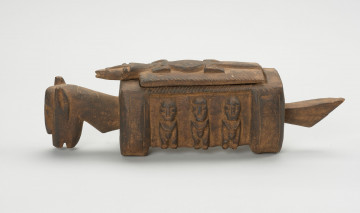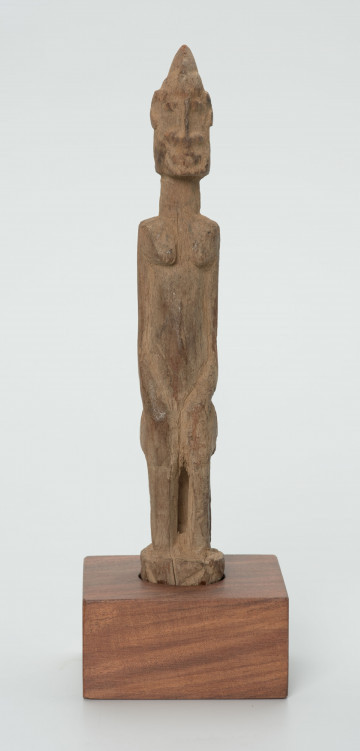Door lock with key
około 1970
National Museum in Szczecin
Part of the collection: Collection of Dogonian art
The bottle gourd, also called calabash (Lagenaria), is a climbing plant in the cucurbitaceae family. In the Dogon country, its fruits are used to make vessels, containers and percussion instruments. The Dogon put rigid material on the young fruit to give it the right form to obtain a calabash of the expected shape, e.g., pear-shaped. The discussed calabash served as a vessel for storing and transporting water. It was entirely covered with knife engravings. The calabashes are also decorated by pyrography using a red-hot metal blade. The vessel is decorated with images of animals of importance in the mythology of the Dogon: a snake identified with the mythical ancestor Lebe and the Dogon image of the world, a crocodile (commonly called a caiman) considered a sacred and protective animal, which brings regular rains and ensures farmers an abundant harvest, and a hornbill (calao), a symbol of motherhood. The calabash is also decorated with images of birds, antelopes, hares and hard to identify dogs and cats. Apart from zoomorphic representations one can notice human figures dancing in masks, which are essential in the Dogon rituals: kanaga, made in the shape of the Jagiellonian cross (a variant of the Lorraine cross), which is the most popular of the Dogon masks and represents the komolo tebu bird, and animal masks - antelope, hare and snake, symbolising the bush, which on the one hand is a source of strength and wisdom, and on the other a source of fear and anxiety. The animal masks bring the wisdom of the bush to the village and are a link between the world of humans and supernatural forces. Dancers wearing kanaga or animal masks are also dressed in rich costumes that are considered part of the mask, including indigo-dyed trousers, skirts made of plant fibres and fibre shoulder and forearm bracelets.
Katarzyna Findlik-Gawron
Author / creator
Dimensions
cały obiekt: height: 53,1 cm
Object type
vessel (container)
Creation time / dating
Creation / finding place
Identification number
Location / status
około 1970
National Museum in Szczecin

między 1951 — 2000
National Museum in Szczecin

między 1901 — 1950
National Museum in Szczecin
DISCOVER this TOPIC
Museum of King Jan III's Palace at Wilanów
DISCOVER this PATH
Educational path